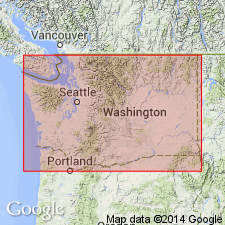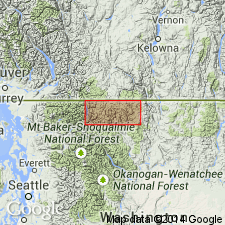
- Usage in publication:
-
- Ashnola gabbro
- Modifications:
-
- Named
- Dominant lithology:
-
- Gabbro
- AAPG geologic province:
-
- Okanogan province
- Cascades province
Summary:
[Named for Ashnola River which it parallels north of the International Boundary]. Is 5-mi-long, northwest-trending body with maximum width of 0.5 mi, nearly bisected by International Boundary [at approximately west longitude 120 deg 15', Okanogan Co, WA]. Shown on geologic sketch map of Cathedral and Remmel batholiths. Is [tan] medium- to coarse-grained augite-hornblende-biotite gabbro, locally gneissic (possibly primary gneissosity) that forms roof pendant in Remmel batholith. Age is inferred to be late Paleozoic (Carboniferous?).
Source: GNU records (USGS DDS-6; Menlo GNULEX).

- Usage in publication:
-
- Ashnola Gabbro*
- Modifications:
-
- Adopted
- Age modified
- AAPG geologic province:
-
- Cascades province
- Okanogan province
Summary:
Ashnola Gabbro of Daly (1906) [adopted]. Authors note faint compositional layering of consistent northeast strike and northwest dip. Layers are composed of olivine-hypersthene gabbro, olivine gabbro, hypersthene gabbro, and pyroxene-hornblende gabbro. Primary minerals are aligned in planes of compositional layering which is at right angles to foliation in adjacent gneisses. These structures provide evidence that gabbro intruded foliated rock after the latter's metamorphism, not before, as thought by Daly (1906). Lack of metamorphism suggests Ashnola is at least as young as Cretaceous.
Source: GNU records (USGS DDS-6; Menlo GNULEX).
For more information, please contact Nancy Stamm, Geologic Names Committee Secretary.
Asterisk (*) indicates published by U.S. Geological Survey authors.
"No current usage" (†) implies that a name has been abandoned or has fallen into disuse. Former usage and, if known, replacement name given in parentheses ( ).
Slash (/) indicates name conflicts with nomenclatural guidelines (CSN, 1933; ACSN, 1961, 1970; NACSN, 1983, 2005, 2021). May be explained within brackets ([ ]).

